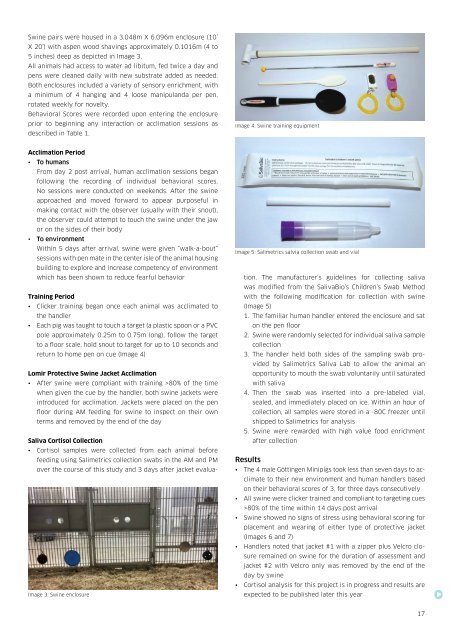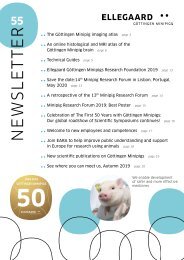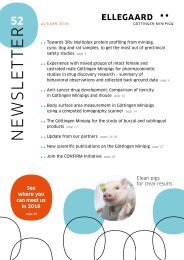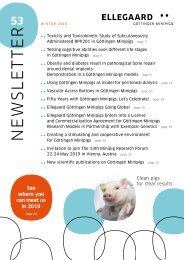Ellegaard_Minipigs_Newsletter_51
Create successful ePaper yourself
Turn your PDF publications into a flip-book with our unique Google optimized e-Paper software.
Swine pairs were housed in a 3.048m X 6.096m enclosure (10’<br />
X 20’) with aspen wood shavings approximately 0.1016m (4 to<br />
5 inches) deep as depicted in Image 3.<br />
All animals had access to water ad libitum, fed twice a day and<br />
pens were cleaned daily with new substrate added as needed.<br />
Both enclosures included a variety of sensory enrichment, with<br />
a minimum of 4 hanging and 4 loose manipulanda per pen,<br />
rotated weekly for novelty.<br />
Behavioral Scores were recorded upon entering the enclosure<br />
prior to beginning any interaction or acclimation sessions as<br />
described in Table 1.<br />
Image 4: Swine training equipment<br />
Acclimation Period<br />
• To humans<br />
From day 2 post arrival, human acclimation sessions began<br />
following the recording of individual behavioral scores.<br />
No sessions were conducted on weekends. After the swine<br />
approached and moved forward to appear purposeful in<br />
making contact with the observer (usually with their snout),<br />
the observer could attempt to touch the swine under the jaw<br />
or on the sides of their body<br />
• To environment<br />
Within 5 days after arrival, swine were given “walk-a-bout”<br />
sessions with pen mate in the center isle of the animal housing<br />
building to explore and increase competency of environment<br />
which has been shown to reduce fearful behavior<br />
Training Period<br />
• Clicker training began once each animal was acclimated to<br />
the handler<br />
• Each pig was taught to touch a target (a plastic spoon or a PVC<br />
pole approximately 0.25m to 0.75m long), follow the target<br />
to a floor scale, hold snout to target for up to 10 seconds and<br />
return to home pen on cue (Image 4)<br />
Lomir Protective Swine Jacket Acclimation<br />
• After swine were compliant with training >80% of the time<br />
when given the cue by the handler, both swine jackets were<br />
introduced for acclimation. Jackets were placed on the pen<br />
floor during AM feeding for swine to inspect on their own<br />
terms and removed by the end of the day<br />
Saliva Cortisol Collection<br />
• Cortisol samples were collected from each animal before<br />
feeding using Salimetrics collection swabs in the AM and PM<br />
over the course of this study and 3 days after jacket evalua-<br />
Image 3: Swine enclosure<br />
Image 5: Salimetrics salvia collection swab and vial<br />
tion. The manufacturer’s guidelines for collecting saliva<br />
was modified from the SalivaBio’s Children’s Swab Method<br />
with the following modification for collection with swine<br />
(Image 5)<br />
1. The familiar human handler entered the enclosure and sat<br />
on the pen floor<br />
2. Swine were randomly selected for individual saliva sample<br />
collection<br />
3. The handler held both sides of the sampling swab provided<br />
by Salimetrics Saliva Lab to allow the animal an<br />
opportunity to mouth the swab voluntarily until saturated<br />
with saliva<br />
4. Then the swab was inserted into a pre-labeled vial,<br />
sealed, and immediately placed on ice. Within an hour of<br />
collection, all samples were stored in a -80C freezer until<br />
shipped to Salimetrics for analysis<br />
5. Swine were rewarded with high value food enrichment<br />
after collection<br />
Results<br />
• The 4 male Göttingen <strong>Minipigs</strong> took less than seven days to acclimate<br />
to their new environment and human handlers based<br />
on their behavioral scores of 3, for three days consecutively<br />
• All swine were clicker trained and compliant to targeting cues<br />
>80% of the time within 14 days post arrival<br />
• Swine showed no signs of stress using behavioral scoring for<br />
placement and wearing of either type of protective jacket<br />
(Images 6 and 7)<br />
• Handlers noted that jacket #1 with a zipper plus Velcro closure<br />
remained on swine for the duration of assessment and<br />
jacket #2 with Velcro only was removed by the end of the<br />
day by swine<br />
• Cortisol analysis for this project is in progress and results are<br />
expected to be published later this year<br />
<br />
17








